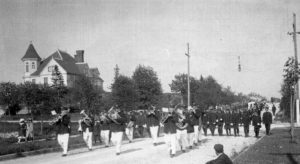With America’s entry into World War I in April of 1917, life changed dramatically for citizens across the country, including those living in Schoolcraft County. A series of sweeping war regulations were established by the administration of Woodrow Wilson regarding food, fuel, the financing of the war effort, the treatment of “enemy aliens” and the stifling of dissent.
The United States Food Administration sought to conserve foods such as beef, pork and wheat through voluntary action. Staples like sugar and flour were rationed. George Nicholson, of the White Marble Lime Company, was appointed as local food administrator. Monday, Wednesday and one meal daily were designated as wheatless. Tuesday and one meal daily was to be meatless. Saturday was porkless. The edicts from the Food Administration were published weekly in the Pioneer Tribune, with compliance being achieved through social pressure. Every family was expected to prominently display the Food Administration emblem in their home.

